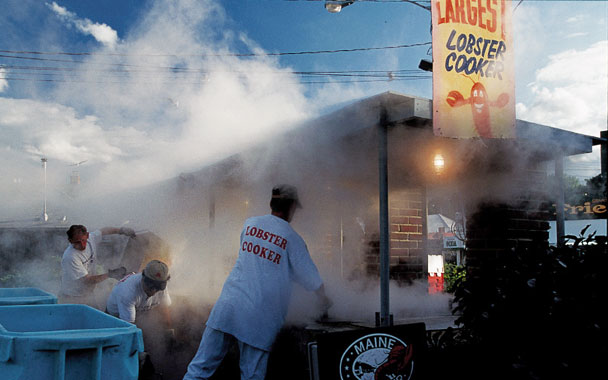The enormous, pungent, and extremely well marketed Maine Lobster Festival is held every late July in the state’s midcoast region, meaning the western side of Penobscot Bay, the nerve stem of Maine’s lobster industry. What’s called the midcoast runs from Owl’s Head and Thomaston in the south to Belfast in the north. (Actually, it might extend all the way up to Bucksport, but we were never able to get farther north than Belfast on Route 1, whose summer traffic is, as you can imagine, unimaginable.) The region’s two main communities are Camden, with its very old money and yachty harbor and five-star restaurants and phenomenal B&Bs, and Rockland, a serious old fishing town that hosts the Festival every summer in historic Harbor Park, right along the water.1
Tourism and lobster are the midcoast region’s two main industries, and they’re both warm-weather enterprises, and the Maine Lobster Festival represents less an intersection of the industries than a deliberate collision, joyful and lucrative and loud. The assigned subject of this article is the 56th Annual MLF, July 30 to August 3, 2003, whose official theme was “Lighthouses, Laughter, and Lobster.” Total paid attendance was over 80,000, due partly to a national CNN spot in June during which a Senior Editor of a certain other epicurean magazine hailed the MLF as one of the best food-themed festivals in the world. 2003 Festival highlights: concerts by Lee Ann Womack and Orleans, annual Maine Sea Goddess beauty pageant, Saturday’s big parade, Sunday’s William G. Atwood Memorial Crate Race, annual Amateur Cooking Competition, carnival rides and midway attractions and food booths, and the MLF’s Main Eating Tent, where something over 25,000 pounds of fresh-caught Maine lobster is consumed after preparation in the World’s Largest Lobster Cooker near the grounds’ north entrance. Also available are lobster rolls, lobster turnovers, lobster sauté, Down East lobster salad, lobster bisque, lobster ravioli, and deep-fried lobster dumplings. Lobster Thermidor is obtainable at a sit-down restaurant called The Black Pearl on Harbor Park’s northwest wharf. A large all-pine booth sponsored by the Maine Lobster Promotion Council has free pamphlets with recipes, eating tips, and Lobster Fun Facts. The winner of Friday’s Amateur Cooking Competition prepares Saffron Lobster Ramekins, the recipe for which is available for public downloading at www.mainelobsterfestival.com. There are lobster T-shirts and lobster bobblehead dolls and inflatable lobster pool toys and clamp-on lobster hats with big scarlet claws that wobble on springs. Your assigned correspondent saw it all, accompanied by one girlfriend and both his own parents—one of which parents was actually born and raised in Maine, albeit in the extreme northern inland part, which is potato country and a world away from the touristic midcoast.2
For practical purposes, everyone knows what a lobster is. As usual, though, there’s much more to know than most of us care about—it’s all a matter of what your interests are. Taxonomically speaking, a lobster is a marine crustacean of the family Homaridae, characterized by five pairs of jointed legs, the first pair terminating in large pincerish claws used for subduing prey. Like many other species of benthic carnivore, lobsters are both hunters and scavengers. They have stalked eyes, gills on their legs, and antennae. There are dozens of different kinds worldwide, of which the relevant species here is the Maine lobster, Homarus americanus. The name “lobster” comes from the Old English loppestre, which is thought to be a corrupt form of the Latin word for locust combined with the Old English loppe, which meant spider.
Moreover, a crustacean is an aquatic arthropod of the class Crustacea, which comprises crabs, shrimp, barnacles, lobsters, and freshwater crayfish. All this is right there in the encyclopedia. And an arthropod is an invertebrate member of the phylum Arthropoda, which phylum covers insects, spiders, crustaceans, and centipedes/millipedes, all of whose main commonality, besides the absence of a centralized brain-spine assembly, is a chitinous exoskeleton composed of segments, to which appendages are articulated in pairs.
The point is that lobsters are basically giant sea-insects.3 Like most arthropods, they date from the Jurassic period, biologically so much older than mammalia that they might as well be from another planet. And they are—particularly in their natural brown-green state, brandishing their claws like weapons and with thick antennae awhip—not nice to look at. And it’s true that they are garbagemen of the sea, eaters of dead stuff,4 although they’ll also eat some live shellfish, certain kinds of injured fish, and sometimes each other.



 Pinterest
Pinterest






